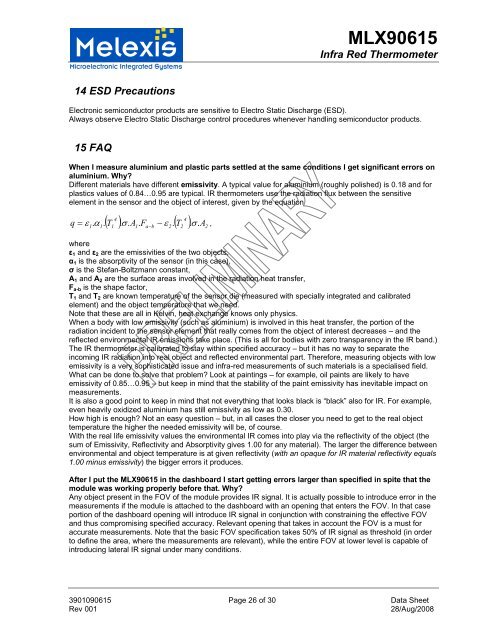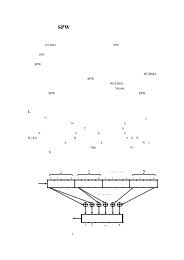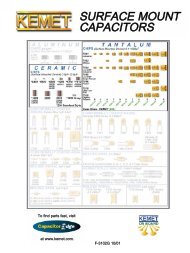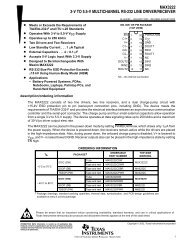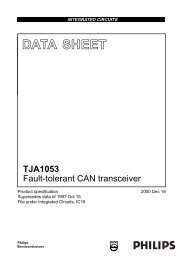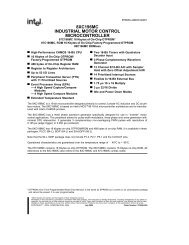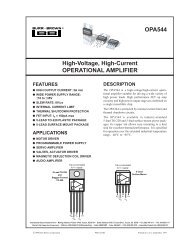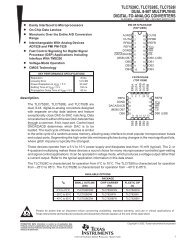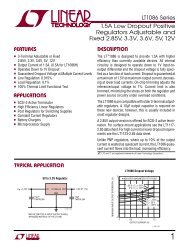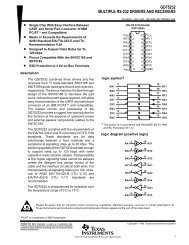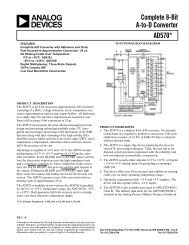MLX90615
MLX90615
MLX90615
- No tags were found...
You also want an ePaper? Increase the reach of your titles
YUMPU automatically turns print PDFs into web optimized ePapers that Google loves.
<strong>MLX90615</strong>Infra Red Thermometer14 ESD PrecautionsElectronic semiconductor products are sensitive to Electro Static Discharge (ESD).Always observe Electro Static Discharge control procedures whenever handling semiconductor products.15 FAQWhen I measure aluminium and plastic parts settled at the same conditions I get significant errors onaluminium. Why?Different materials have different emissivity. A typical value for aluminium (roughly polished) is 0.18 and forplastics values of 0.84…0.95 are typical. IR thermometers use the radiation flux between the sensitiveelement in the sensor and the object of interest, given by the equation44( T1).σ.A1. Fab− ε2.( T2).2q = ε−. ,1. α1.σ Awhereε 1 and ε 2 are the emissivities of the two objects,α 1 is the absorptivity of the sensor (in this case),σ is the Stefan-Boltzmann constant,A 1 and A 2 are the surface areas involved in the radiation heat transfer,F a-b is the shape factor,T 1 and T 2 are known temperature of the sensor die (measured with specially integrated and calibratedelement) and the object temperature that we need.Note that these are all in Kelvin, heat exchange knows only physics.When a body with low emissivity (such as aluminium) is involved in this heat transfer, the portion of theradiation incident to the sensor element that really comes from the object of interest decreases – and thereflected environmental IR emissions take place. (This is all for bodies with zero transparency in the IR band.)The IR thermometer is calibrated to stay within specified accuracy – but it has no way to separate theincoming IR radiation into real object and reflected environmental part. Therefore, measuring objects with lowemissivity is a very sophisticated issue and infra-red measurements of such materials is a specialised field.What can be done to solve that problem? Look at paintings – for example, oil paints are likely to haveemissivity of 0.85…0.95 – but keep in mind that the stability of the paint emissivity has inevitable impact onmeasurements.It is also a good point to keep in mind that not everything that looks black is “black” also for IR. For example,even heavily oxidized aluminium has still emissivity as low as 0.30.How high is enough? Not an easy question – but, in all cases the closer you need to get to the real objecttemperature the higher the needed emissivity will be, of course.With the real life emissivity values the environmental IR comes into play via the reflectivity of the object (thesum of Emissivity, Reflectivity and Absorptivity gives 1.00 for any material). The larger the difference betweenenvironmental and object temperature is at given reflectivity (with an opaque for IR material reflectivity equals1.00 minus emissivity) the bigger errors it produces.After I put the <strong>MLX90615</strong> in the dashboard I start getting errors larger than specified in spite that themodule was working properly before that. Why?Any object present in the FOV of the module provides IR signal. It is actually possible to introduce error in themeasurements if the module is attached to the dashboard with an opening that enters the FOV. In that caseportion of the dashboard opening will introduce IR signal in conjunction with constraining the effective FOVand thus compromising specified accuracy. Relevant opening that takes in account the FOV is a must foraccurate measurements. Note that the basic FOV specification takes 50% of IR signal as threshold (in orderto define the area, where the measurements are relevant), while the entire FOV at lower level is capable ofintroducing lateral IR signal under many conditions.3901090615 Page 26 of 30 Data SheetRev 00128/Aug/2008


